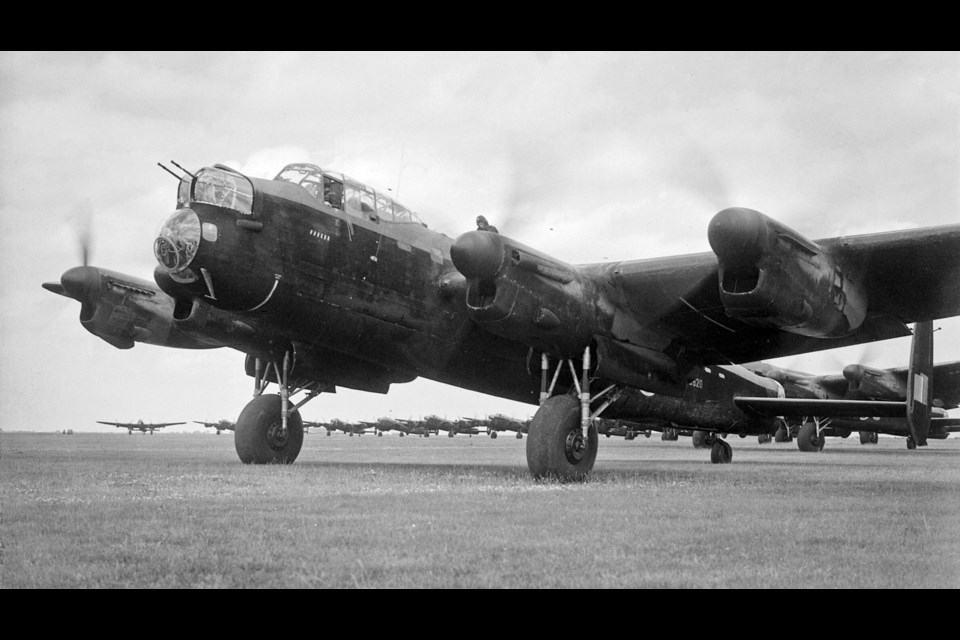A bombing mission went horribly wrong for Moose Jaw-area pilot Harold Allan Hannah 75 years ago, an event that forced his crew to crash land and that eventually led to his death.
Hannah, born on a farm west of Moose Jaw near Tuxford, and his crew had been together since Jan. 23, 1944. They had taken part in 18 operations flying Halifax bombers, including two missions on D-Day on June 6, 1944.
The crew did such a good job that it was asked to join the Pathfinders squadron, which — although quite the honour — meant performing a double tour instead of being sent home.
In 1984, navigator Flying Officer J.L. Cope spoke to journalist Jo-Anne Ashe about the fateful night of Nov. 3-4, 1944 and their mission to Dusseldorf, Germany. His memories, and that of fellow crewman Flight Lt. George Albert Martin, were collected on the website Aircrew Remembered by Hannah’s nephew, David Langner.
Commence mission
On that evening, the crew — now flying Lancaster Type III bomber PB413 and nicknamed King — was carrying several types of bombs, including ones that emitted coloured smoke to help bombers flying behind to know where to drop their loads.
This was the crew’s 31st operation; they took off for the Ruhr (Happy) Valley at 0530.
“On the inevitable ‘last’ leg running up to the target, there wasn’t a cloud in the sky, which makes a blind-marker feel rather naked,” Cope said.
Since the bomber was 22 minutes later than expected, the Germans had time to prepare their anti-air defences, including searchlights so bright it was similar to driving down a city street, he continued. The crew had previously flown through searchlights and flak without being hit, but this time, they were coned — when all the searchlights focus on one spot — and Hannah had to take evasive action.
One shell burst above the plane and the only hole in the bomber was into the canopy above the pilot. A piece of shrapnel entered Hannah’s lung and he immediately went unconscious, slumping over the control column.
Controlling the plane
Cope, Martin and another crewman left their seats and wrestled the pilot out of his chair, which wasn’t easy in a confined space and with everyone tangled in intercom wires and oxygen tubes, said Cope. It took them five minutes to get Hannah out of his seat; they dumped him onto the floor so Martin could regain control of the plane.
“During that time we flip-flopped all over the sky. When one of us saw the nose-diving we’d all pull back on the stick,” he continued. “I’m sure we almost looped the loop at times.”
The plane lost altitude and went from 17,000 feet to 5,000 feet, its bomb bay doors still open. Martin had never flown an aircraft before but had practised on a training machine. With instructions from Cope to turn northwest back to England, Martin climbed back to 10,000 feet and headed home.
“The mass of dials before me made it impossible to sort out compass, altimeter or airspeed indicator,” said Martin afterward. “There seemed to be hundreds of them. I had so little idea of our position in the sky that quite literally I didn’t know which way was ‘up.’”
The crew couldn’t do much to help Hannah except to give him a shot of morphine and pain pills, Cope recalled. Hannah remained unconscious all the way home. There wasn’t much blood, but it was clear Hannah was badly hurt.
No help from home
The plane was now two hours past its return deadline, so the crew received no response from its home base at Gransden Lodge when it radioed for help. However, the United States Army Air Force base at Debden answered and turned on all the runway lights.
“The control tower proceeded to talk us down — like you’d see in a movie,” Cope said. Martin made a final turn toward the runway and prepared to make a belly landing. The controller informed Martin that he was too high and off the runway. Cope remembers Martin saying in his English accent, “OK, I’ll go around again.”
However, while Martin pulled back on the stick, he didn’t give the machine enough throttle and immediately went into a gentle stall, recalled Cope. Since he was too high, Martin had to glide half a mile past the base toward the only open field. During the descent the plane missed the top of a farmhouse by inches.
The ground sloped away, which caught the tail first and made the landing as ideal as possible.
A safe landing
“To be truthful … I thought this was the end and expected all sorts of bits and pieces to be flying around. But nothing! Just calm and quiet!” said Cope.
Said Martin, “I now became aware of someone saying, ‘Stop you bastard, stop you bastard!,’ while I was shoving with my feet on the rudder bar and hauling back on the column like someone trying to halt a runaway team of horses. And at least I realized the character talking was me. We were down. It had come off.”
In what seems like seconds, fire trucks and ambulances with the USAAF arrived on scene with their red lights flashing. Hannah was taken to the hospital while the crew went to the Officers’ Mess for several large shots of scotch to settle their nerves.
Martin was later awarded a Distinguished Service Order (DSO) medal, one of the highest military honours given in the British Empire.
Harold Allan Hannah never recovered from his injuries and died Jan. 27, 1945. He is buried in Harrogate (Stonefall) Cemetery in Yorkshire, United Kingdom, where his older brother Lloyd Albert Hannah is also buried. The older Hannah died in a plane crash in October 1944 before the start of a similar bombing mission.




